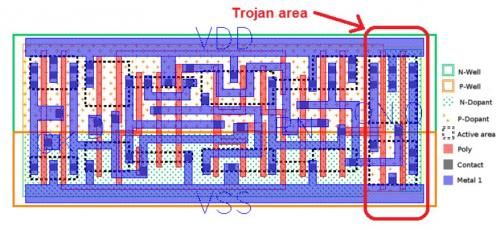
New research suggests that hardware used by the military may be compromised with malicious trojan software without being detected.
Phys.org reports:
Worries that the security of integrated circuits used in critical systems by the military and industry can be compromised are all the more real with the release of a research paper titled “Stealthy Dopant-Level Hardware Trojans.” The authors are a research team from United States, the Netherlands, Switzerland and Germany.
They showed that integrated circuits can be maliciously compromised. The changes elude detection. Even physical inspection of the chip will not pick up the changes made. The authors discussed how they succeeded in modifying a circuit and yet detection mechanisms did not find anything amiss. The authors wrote that “we propose an extremely stealthy approach for implementing hardware Trojans below the gate level.”
Instead of adding additional circuitry to the target design, the researchers inserted their hardware Trojans by changing “the dopant polarity of existing transistors.”
That way, the modified circuit nonetheless appeared as legitimate on all wiring layers, including all metal and polysilicon. The team said that their family of Trojans was resistant to most detection techniques such as fine-grain optical inspection and checks against “golden chips.”
The researchers tested their Trojan on Intel’s random number generator design used in Ivy Bridge processors, as well as a Side-channel Trojan.
In deciding on this second case, they authors said that, after showing how their dopant Trojan could be used to compromise the security of a real world system, they turned to the second case study, where they wanted to emphasize the flexibility of the dopant Trojan. “Instead of modifying the logic behavior of a design, the dopant Trojan is used to establish a hidden side-channel to leak out secret keys.”
What do they mean by dopant? Threatpost said that “Dopant is a material that is added to semiconductor material that enables it to be electrically conductive.” Computerworld explains doping as a process for modifying the electrical properties of silicon by introducing impurities such as gallium and phosphorous into the crystal. Changes made at the atomic level are difficult to detect.
Explaining their work further, the authors said that “In this paper we introduced a new type of sub-transistor level hardware Trojan that only requires modification of the dopant masks. No additional transistor gates are added and no other layout mask needs to be modified. Since only changes to the metal, polysilicon or active area can be reliably detected with optical inspection, our dopant Trojans are immune to optical inspection.”
This type of Trojan under discussion is said to pose a great challenge. The authors commented that “They set a new lower bar on how much overhead can be expected from a hardware Trojan in practice (i.e. zero!).” The authors recommended that future work should include developing new methods to detect these “sub-transistor level hardware Trojans.”

